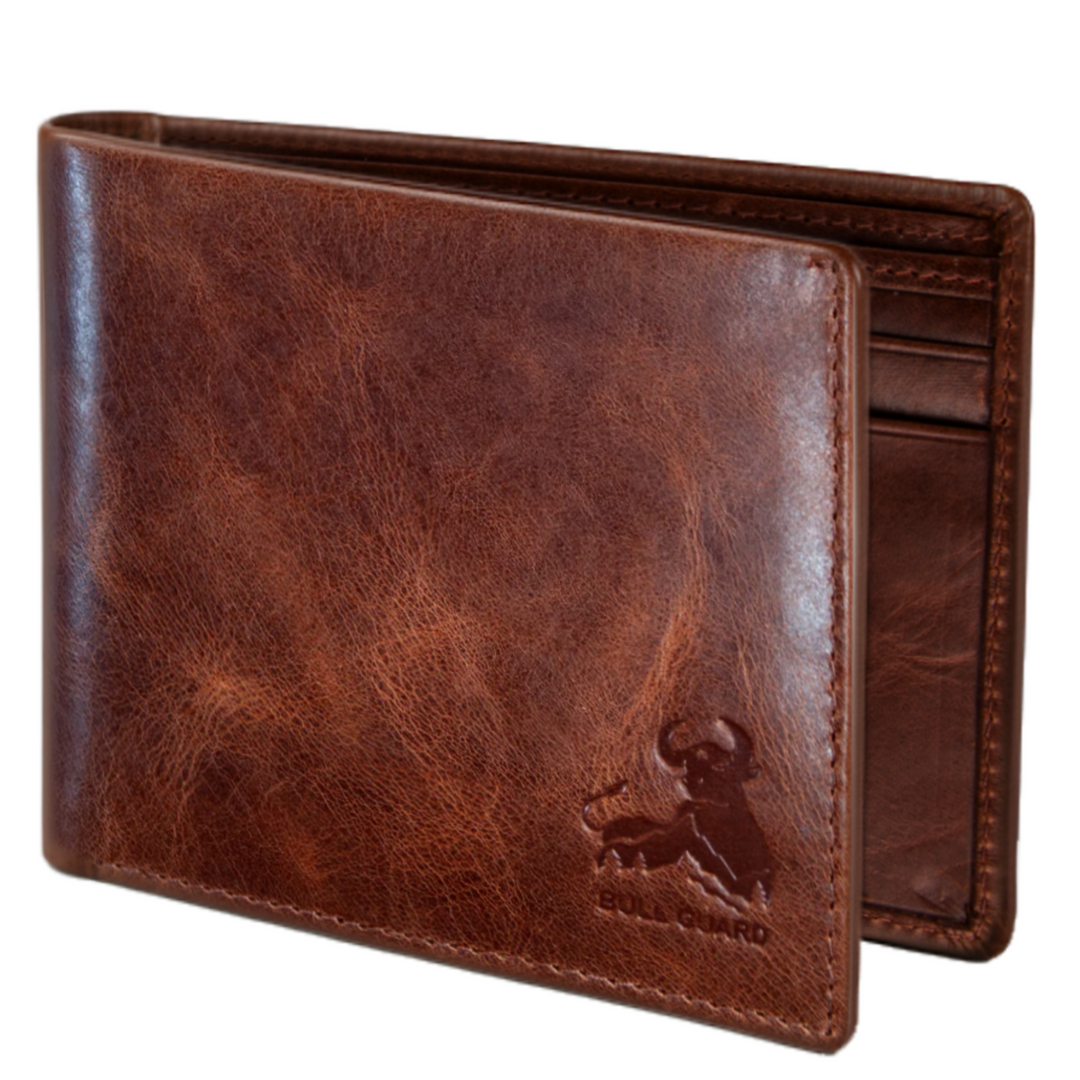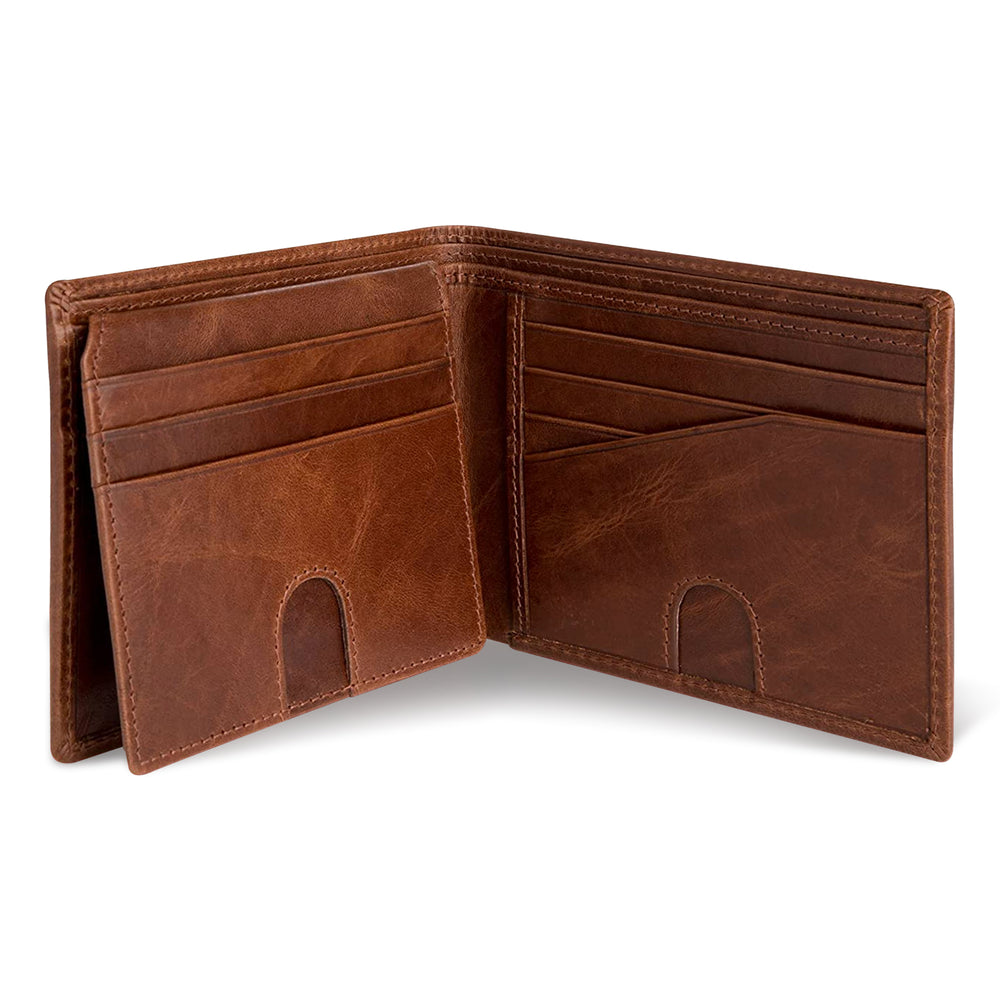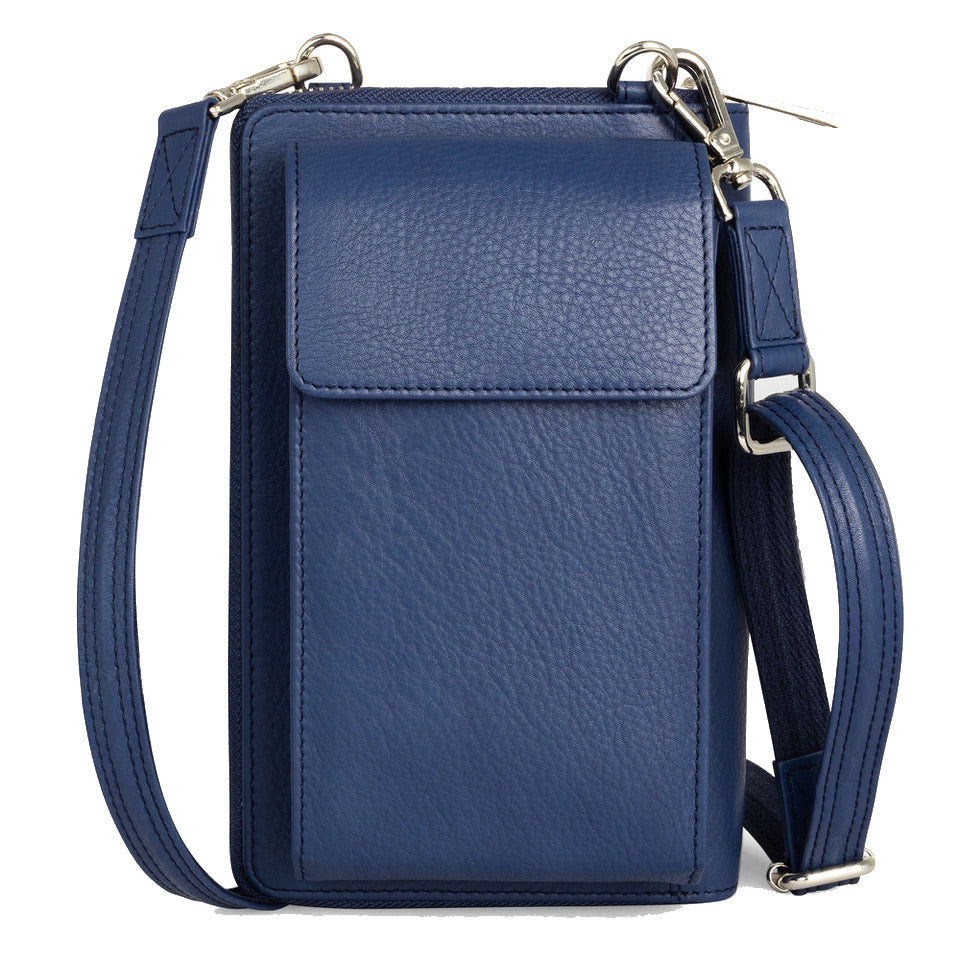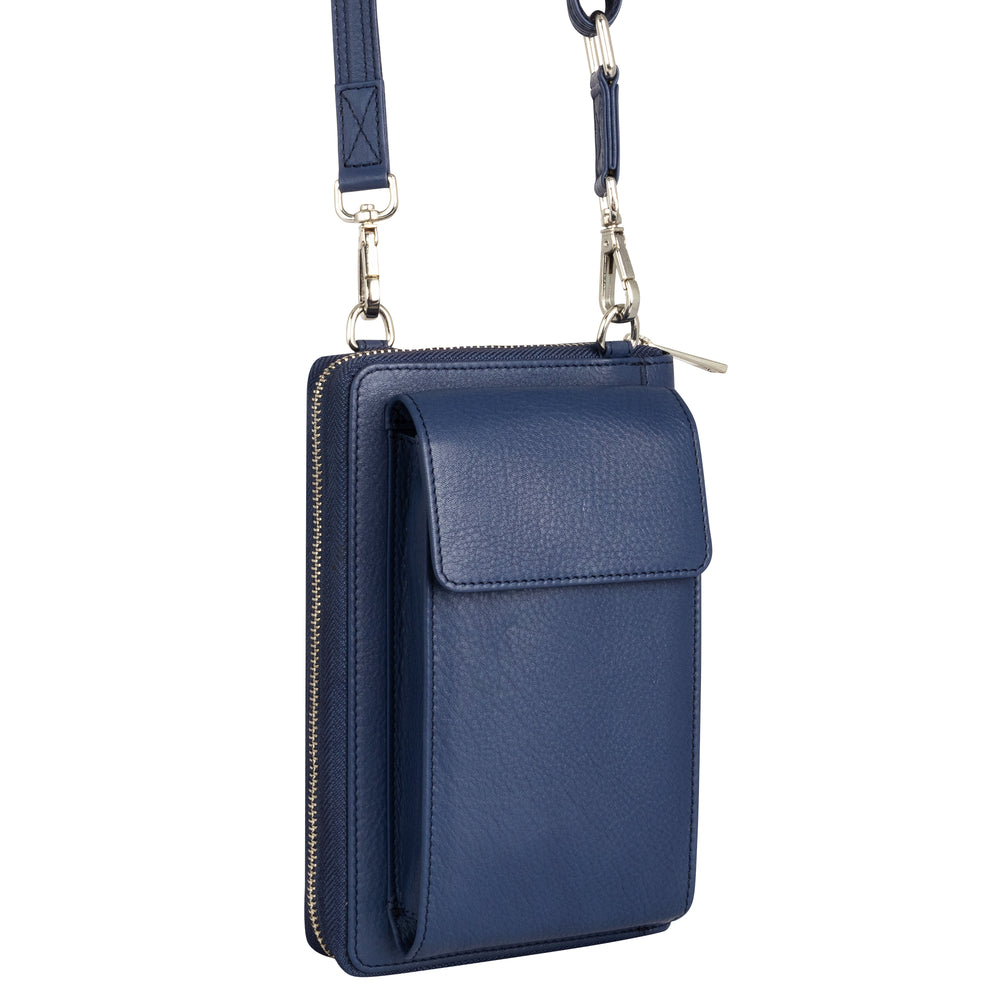Key Takeaways
- Leather is made from the outer grain side of animal hide, which is naturally dense and fibrous.
- The outer grain layer of leather resists abrasion, moisture, and daily wear.
- Tanning processes transform the tough animal hide into smooth, structured leather material.
- Leather is commonly used in products like bifold wallets and crossbody straps.
Leather and Suede – Foundations for a Life Boldly Carried
Understanding Leather and Suede – Origins, Processes & Core Qualities
What is Leather?
Leather emerges from the outer grain side of animal hide, the layer that faced the world during the animal's life. This dense, fibrous surface naturally resists abrasion, moisture, and daily wear. Through careful tanning processes, this tough exterior transforms into the smooth, structured material that defines our bifold wallets and crossbody straps.
The grain pattern you see on quality leather tells the animal's story, natural scars, wrinkles, and texture variations that make each piece unique. Full-grain leather preserves this entire surface, while top-grain removes minor imperfections while maintaining strength and character.
What is Suede?
Suede begins where leather ends, literally. After the outer grain layer becomes leather, the remaining inner flesh split gets sanded and buffed to raise thousands of tiny fibers. This creates suede's distinctive nap, that soft, directional texture that feels like velvet between your fingers.
Unlike leather's protective barrier, suede invites touch. Its porous surface absorbs oils and develops subtle color shifts over time, making it perfect for wallet linings and accent details where comfort matters more than armor-like protection.
How They're Made – Tanning and Finishing Methods
Both materials start their journey in the same tanning drums, where raw hides soak in solutions that prevent decay and add flexibility. Chrome tanning creates consistent, supple results in days, while vegetable tanning uses tree bark extracts over months, producing the rich, aging characteristics we prize in our Crazy Horse leather.
The split happens during processing, a precise blade separates the grain layer (destined for leather) from the flesh layer (future suede). This explains why suede leather terminology confuses people, suede is technically a leather product, just from a different part of the hide.
At Bull Guard, we source only from tanneries that prioritize ethical practices and environmental responsibility. The difference shows in how our materials age, developing character rather than simply wearing down.
Leather and Suede in Bull Guard Craft: Our Materials, Stories & Standards

Bull Guard Material Choices – Full-Grain & Top-Grain Only
We reject 98% of available hides because most lack the tight grain structure and natural resilience our customers deserve. Full-grain leather, the gold standard, retains the complete surface layer, ensuring your wallet develops that coveted patina while maintaining structural integrity through years of daily carry.
Top-grain leather, our second choice, removes surface imperfections while preserving the dense fiber network beneath. Both options guarantee your Bull Guard piece will age gracefully, softening and darkening in response to your unique handling patterns and environment.
Most Loved Bull Guard Leathers and Suedes
Napa leather offers buttery smoothness for dress occasions, while Crazy Horse develops dramatic color shifts with use. Saffiano provides scratch resistance through its crosshatch embossing, and Buffalo leather delivers rugged character for outdoor adventures.
Our suede applications focus on interior linings and accent panels where that velvet touch enhances daily interaction. The turquoise crossbody features suede panels that soften against clothing, while several wallet models use suede-lined card slots for smooth insertion and removal.
Real People, Real Adventures – Living with Leather and Suede
Leather vs Suede: Deep-Dive Comparison for Everyday Life
For a deeper dive into the differences between leather and suede and how they influence bag and accessory design, explore our expert guide.
| Leather | Suede | |
|---|---|---|
| Surface | Dense, smooth, protective grain | Soft, napped, velvety texture |
| Durability | Highly resistant to abrasion and moisture | More prone to stains and scuffs; needs care |
| Patina | Develops rich color and sheen with age | Nap flattens and darkens in high-contact areas |
| Best Use | Wallet exteriors, straps, high-wear items | Linings, accents, comfort-focused details |
| Care | Condition with leather balm; wipe clean | Brush nap; use suede protector spray |
The Science of Durability & Performance – Data, Myths & Real-World Results
Scientific Backing: Leather vs Suede Durability Stats
Average full-grain leather tensile strength: 25–35 MPa
Suede: 10-18 MPa (varies by animal/source)
Test result highlights: 18+ months of daily Bull Guard use, leather wallets "look new," suede linings remain plush.
Why Leather Outlasts and How to Maximize Longevity
Leather's superior durability stems from its dense fiber network, the same structure that protected the animal now protects your essentials. These tightly woven collagen fibers resist tearing and stretching while allowing natural flexibility. When properly conditioned, leather actually strengthens over time as oils penetrate and bind the fiber structure.
Our RFID-blocking technology adds another protection layer without compromising leather integrity. The thin metallic mesh integrates seamlessly, ensuring your wallet blocks electronic theft while maintaining the material's natural breathing and aging properties.
Is Suede Too Delicate? – Addressing Common Concerns
Modern suede treatments have revolutionized durability without sacrificing texture. Protective sprays create invisible barriers against moisture and stains, while reinforced construction techniques strengthen stress points. Our suede-lined compartments feature edge binding that prevents fraying while maintaining the soft interior experience.
Real-world testing proves suede's resilience when properly applied. After two years of daily commuting, hiking, and travel, our crossbody suede panels show minimal wear while retaining their signature comfort.
Leather and Suede in the Elements – Weather, Wear, and Reaction
Leather embraces weather challenges, rain beads off treated surfaces, cold weather firms the structure temporarily, and heat allows natural oils to redistribute for self-conditioning. Full-grain leather's tight surface repels most moisture while allowing internal breathability that prevents cracking.
Suede requires environmental awareness but rewards careful handling. Light moisture evaporates without damage, but saturation can mat the nap permanently. Temperature extremes affect suede less than leather, making it ideal for climate-controlled environments where its comfort advantages shine. For more on the science behind suede, see this authoritative overview of suede.
Mastering Care for Leather and Suede – Techniques, Products, Troubleshooting

How to Clean and Condition Leather
Proper care is essential for extending the life of your leather and suede accessories. For tips on maintaining your wallet's appearance and durability, check out our guide to a durable leather wallet for everyday use.
- Leather: Wipe with a soft, damp cloth. Use a pH-balanced leather cleaner for deeper cleaning. Condition with a quality leather balm every few months to restore oils and prevent cracking.
- Suede: Brush gently with a suede brush to lift the nap and remove dirt. Use a suede eraser for stains. Apply a suede protector spray to guard against moisture and stains.
If your accessory gets wet, blot gently with a dry cloth and allow it to air dry away from direct heat. For stubborn stains or deep cleaning, consult a leather care professional.
Leather and Suede Wallets & Accessories – The Bull Guard Collection, Explained
Men's Wallet Types – Which Leather Works Best?
Bifold with Flip Up ID – Classic construction demands full-grain leather's structural integrity. The repeated folding action requires dense fiber networks that maintain shape through thousands of cycles.
Trifold – Extra compartments benefit from top-grain leather's flexibility, while the hidden pocket accommodates AirTags or emergency cash. Our Freedom Trifold features dual ID windows with suede-soft interior touches.
Slim Minimalist with AirTag – Vintage leather and suede combinations create sophisticated texture contrast while maintaining ultra-thin profiles. The removable insert system allows two-card carry when maximum portability matters.
Women's Crossbody Models – Style, Utility, Daily Boldness
Our Regular crossbody accommodates phones up to 6.7 inches with room for essentials, while XtraRoom expands capacity for larger devices and additional daily items. Both feature fully adjustable straps (28-54 inches) and passport-ready dimensions for seamless travel.
Suede interior panels provide tactile warmth when retrieving items, while exterior leather withstands weather and wear. The slash-proof strap construction and YKK zippers ensure security without sacrificing style, perfect for grocery runs, commutes, or hands-free adventures with children. For more options, browse our women's wallet collection.
No-Logo, Eagle, Snake Editions – Personalization Without Compromise
Function-first design meets personal expression through our varied branding options. Whether you prefer the iconic bull, soaring eagle, coiled snake, or clean brandless aesthetic, every piece maintains identical quality standards and RFID protection.
Sustainability, Ethics & the Future of Leather and Suede
Responsible Sourcing – What We Do Differently
We trace every hide to certified suppliers who meet strict animal welfare standards and employ eco-friendly tanning processes. Chrome-free vegetable tanning reduces environmental impact while producing leather that ages more beautifully than chemically processed alternatives.
Quality and conscience align when materials last decades rather than seasons. Our commitment to using only the top 2% of available hides means fewer resources consumed per functional year, reducing overall environmental footprint through longevity.
Eco-Friendly Alternatives & The Real Impact
Mushroom leather, recycled synthetics, and plant-based suede alternatives show promise for specific applications. However, life-cycle analysis reveals that well-made, long-lasting traditional leather and suede often outperform synthetic alternatives in total environmental cost when durability factors are included. For a technical perspective on leather processing, see this university resource on leather.
Leather and Suede in Culture, Craft, and Self-Expression

Why We Carry – Stories from Marcela
Each Bull Guard wallet becomes a chapter of real life, mine, our team's, and yours. With every mark and patina, stories unfold: city commutes, mountain hikes, dinner dates that run late. These aren't just accessories; they're loyal companions that unlock inner strength, invite adventure, and empower you to carry life boldly. As you live with them, they soften, adapt, and become a trusted extension of who you are, strong, grounded, and always ready for anything. That's the Bull Guard promise: to help you unleash your untamed spirit, one well-made piece at a time.
Frequently Asked Questions
What are the key differences between full-grain leather and top-grain leather in terms of durability and appearance?
Full-grain leather preserves the entire outer surface of the animal hide, including natural scars and texture, making it the most durable and character-rich option that develops a unique patina over time. Top-grain leather removes minor imperfections for a smoother, more uniform appearance while maintaining strong durability, offering a refined look with slightly less ruggedness than full-grain.
How is suede made from the animal hide, and why does it require more delicate care compared to leather?
Suede is created by sanding and buffing the inner flesh split of the animal hide after the outer grain layer is removed, raising a soft, velvety nap. Unlike leather's dense, protective grain surface, suede's porous texture absorbs oils and moisture easily, making it more vulnerable to stains and wear, thus requiring gentler handling and specialized care.
What tanning processes are used to transform raw hides into leather and suede, and how do they affect the material's characteristics?
Chrome tanning uses chemical solutions to quickly produce supple, consistent leather, ideal for smooth finishes, while vegetable tanning employs natural tree bark extracts over a longer period, resulting in leather with richer color depth and aging qualities like those found in Crazy Horse leather. Both methods prepare the hide for either full-grain leather or suede, influencing durability, texture, and how the material develops character over time.
How does Bull Guard ensure ethical sourcing and environmental responsibility in their leather and suede materials?
Bull Guard commits to sourcing leather and suede from suppliers who prioritize ethical animal treatment and environmentally responsible tanning practices. We focus on transparency and select materials processed with sustainable methods that reduce waste and chemical impact, ensuring our products honor both craftsmanship and conscious living.










